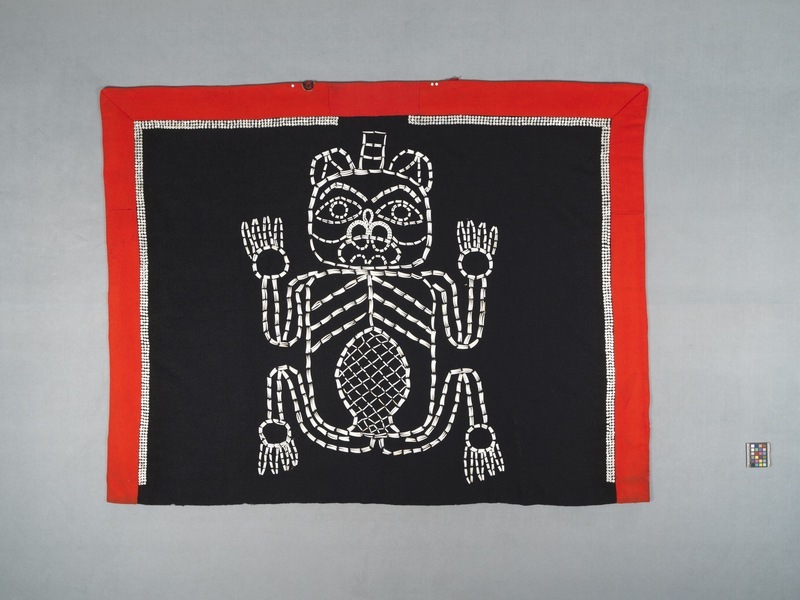Button Blanket Item Number: 3260/59 from the MOA: University of British Columbia

Description
Dark blue button blanket with red border at top and sides. Main central image made of dentalium shells is a beaver. Triple rows of small buttons along most of red border.
History Of Use
Button robes may date back as early as the first decades of the 19th century, when wool blankets became available from Russian traders and the Hudson’s Bay Company. Materials like bright red and dark blue woollen cloth and mother-of-pearl buttons were readily absorbed into regalia-making, eventually replacing similar crest-bearing robes made of laboriously prepared hides or cedar bark. Similarly, using dentalium shells to create the applied designs was a technique transferred from earlier forms of ceremonial garments. Dentalia are the tusk-shaped shells of molluscs that live on the seafloor, beyond the tide line. They are found along the Pacific coast from Alaska to California; the Nuu-chah-nulth were known as the primary harvesters and traders of this precious commodity, traded for centuries throughout the Northwest Coast and as far inland as the Canadian Plateau. The shells have natural openings on either end, and so do not require modification to use as beads.
Iconographic Meaning
Crest image of a beaver with its patterned tail.
Item History
- Made in Haida Gwaii, British Columbia, Canada between 1850 and 1880
- Owned by Elspeth McConnell before August 12, 2017
- Received from Elspeth McConnell (Donor) on August 12, 2017
What
- Name
- Button Blanket
- Identification Number
- 3260/59
- Type of Item
- blanket
- Material
- wool fibre, cotton fibre, dentalium shell, shell and glass
- Overall
- height 141.0 cm, width 184.5 cm
Who
- Culture
- Haida
- Previous Owner
- Elspeth McConnell
- Received from
- Elspeth McConnell (Donor)
Where
- Holding Institution
- MOA: University of British Columbia
- Made in
- Haida Gwaii, British Columbia, Canada
When
- Creation Date
- between 1850 and 1880
- Ownership Date
- before August 12, 2017
- Acquisition Date
- on August 12, 2017
Other
- Item Classes
- textiles
- Condition
- good
- Accession Number
- 3260/0059